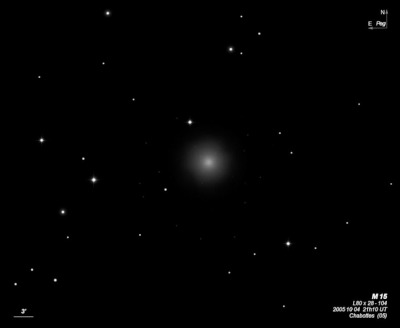
Jean-Dominique Maraldi discovered M15 = NGC 7078 = h2120 on 7 Sept 1746 at the Paris Observatory while tracking Comet de Cheseaux of 1746. Four nights later he discovered M2. Messier made an independent discovery on 3 Jan 1764, as well as Johann Bode on 23 Sep 1774.
William Herschel made an early observation using his 6-inch (10-ft focal length) on 31 May 1783 and commented, "all fairly resolved into stars." On 19 Oct 1784, he described "a beautiful cl. of v compressed and numerous stars, the most compressed part about 2' dia, the next about 7 or 8'; and all the stars within about 15' seem still to belong to the same by the colour, the size, the regular scattering and the gradual accumulation. The general figure is round; but within the space of 6 or 7' the stars are arranged in a sort of a square."
John Herschel reported "vB; vL; irreg. R; g b and v s m b M. A magnificent globular cluster; comes up to a perfect blaze in the centre, like a protuberance or nipple; not the condensation of a homogeneous globe; it has straggling streams of stars, as it were, drawing to a centre. It is not round. Has a * 8m, 30s following in parallel."
200/250mm - 8" very bright, large, intense core is very compact and dense, surrounded by inner halo with many stars superimposed, outer halo well resolved into long distinct streamers. A mag 7.6 star is at the NNE edge of the halo.
300/350mm - 13.1" very bright, very large, very small intense nucleus surrounded by a bright core. Superb resolution down to the center of core.
400/500mm - 17.5" (8/5/94): extremely bright with a halo extending to about 11' diameter and a 3' very bright core containing a 30" intense nucleus. The halo is very highly resolved into fairly bright stars although the stars are irregularly scattered in the outer halo. The halo extends 85% to mag 7.7 SAO 107179 just off the NNE edge of the halo and many stars in the halo appear to be arranged in loops and strings. The core is extremely densely packed with stars down to a very small intense glow at the center. This 30" nucleus is concentrated to the geometric center ("core collapse"). The faint planetary Pease 1 is situated just 30" NNE of center (see observation).
Naked-eye - (7/11/07): easily visible naked-eye at Lassen National Park as a small, hazy spot just west of a 6th magnitude star.
(7/26/06): Located 17' W of a naked-eye mag 6.1 star. The globular was sometimes visible naked-eye as a faint haze to the west of the star.
Notes by Steve Gottlieb